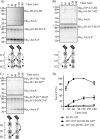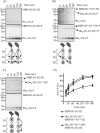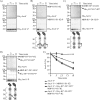Routes of phosphoryl group transfer during signal transmission and signal decay in the dimeric sensor histidine kinase ArcB
- PMID: 29945971
- PMCID: PMC6109937
- DOI: 10.1074/jbc.RA118.003910
Routes of phosphoryl group transfer during signal transmission and signal decay in the dimeric sensor histidine kinase ArcB
Abstract
The Arc (anoxic redox control) two-component system of Escherichia coli, comprising ArcA as the response regulator and ArcB as the sensor histidine kinase, modulates the expression of numerous genes in response to respiratory growth conditions. Under reducing growth conditions, ArcB autophosphorylates at the expense of ATP, and transphosphorylates ArcA via a His292 → Asp576 → His717 → Asp54 phosphorelay, whereas under oxidizing growth conditions, ArcB catalyzes the dephosphorylation of ArcA-P by a reverse Asp54 → His717 → Asp576 → Pi phosphorelay. However, the exact phosphoryl group transfer routes and the molecular mechanisms determining their directions are unclear. Here, we show that, during signal propagation, the His292 → Asp576 and Asp576 → His717 phosphoryl group transfers within ArcB dimers occur intra- and intermolecularly, respectively. Moreover, we report that, during signal decay, the phosphoryl group transfer from His717 to Asp576 takes place intramolecularly. In conclusion, we present a mechanism that dictates the direction of the phosphoryl group transfer within ArcB dimers and that enables the discrimination of the kinase and phosphatase activities of ArcB.
Keywords: ArcB/A two-component system; bacteria; bacterial signal transduction; conformation; histidine kinase; intermolecular phosphotransfer; intramolecular phosphotransfer; phosphorelay; phosphoryl transfer; phosphorylation; sensor kinase.
© 2018 Teran-Melo et al.
Conflict of interest statement
The authors declare that they have no conflicts of interest with the contents of this article
Figures








Similar articles
-
Phosphorelay as the sole physiological route of signal transmission by the arc two-component system of Escherichia coli.J Bacteriol. 2000 Jul;182(13):3858-62. doi: 10.1128/JB.182.13.3858-3862.2000. J Bacteriol. 2000. PMID: 10851007 Free PMC article.
-
The SixA phospho-histidine phosphatase modulates the ArcB phosphorelay signal transduction in Escherichia coli.FEBS Lett. 2000 Mar 24;470(2):118-24. doi: 10.1016/s0014-5793(00)01303-x. FEBS Lett. 2000. PMID: 10734219
-
In vitro and in vivo analysis of the ArcB/A redox signaling pathway.Methods Enzymol. 2010;471:205-28. doi: 10.1016/S0076-6879(10)71012-0. Epub 2010 Mar 1. Methods Enzymol. 2010. PMID: 20946850
-
Signaling by the arc two-component system provides a link between the redox state of the quinone pool and gene expression.Antioxid Redox Signal. 2006 May-Jun;8(5-6):781-95. doi: 10.1089/ars.2006.8.781. Antioxid Redox Signal. 2006. PMID: 16771670 Review.
-
His-Asp phosphotransfer signal transduction.J Biochem. 1998 Apr;123(4):555-63. doi: 10.1093/oxfordjournals.jbchem.a021972. J Biochem. 1998. PMID: 9538242 Review.
Cited by
-
Pseudomonas aeruginosa as a Model To Study Chemosensory Pathway Signaling.Microbiol Mol Biol Rev. 2021 Jan 13;85(1):e00151-20. doi: 10.1128/MMBR.00151-20. Print 2021 Feb 17. Microbiol Mol Biol Rev. 2021. PMID: 33441490 Free PMC article. Review.
-
A Novel Redox-Sensing Histidine Kinase That Controls Carbon Catabolite Repression in Azoarcus sp. CIB.mBio. 2019 Apr 9;10(2):e00059-19. doi: 10.1128/mBio.00059-19. mBio. 2019. PMID: 30967457 Free PMC article.
-
Sequestration of histidine kinases by non-cognate response regulators establishes a threshold level of stimulation for bacterial two-component signaling.Nat Commun. 2023 Jul 25;14(1):4483. doi: 10.1038/s41467-023-40095-2. Nat Commun. 2023. PMID: 37491529 Free PMC article.
-
Theoretical study of ArcB and its dimerization, interaction with anaerobic metabolites, and activation of ArcA.PeerJ. 2023 Oct 13;11:e16309. doi: 10.7717/peerj.16309. eCollection 2023. PeerJ. 2023. PMID: 37849831 Free PMC article.
-
Hybrid Histidine Kinase BinK Represses Vibrio fischeri Biofilm Signaling at Multiple Developmental Stages.J Bacteriol. 2021 Jul 8;203(15):e0015521. doi: 10.1128/JB.00155-21. Epub 2021 Jul 8. J Bacteriol. 2021. PMID: 34031036 Free PMC article.
References
-
- Jung W. S., Jung Y. R., Oh D. B., Kang H. A., Lee S. Y., Chavez-Canales M., Georgellis D., and Kwon O. (2008) Characterization of the Arc two-component signal transduction system of the capnophilic rumen bacterium Mannheimia succiniciproducens. FEMS Microbiol. Lett. 284, 109–119 10.1111/j.1574-6968.2008.01187.x - DOI - PubMed
-
- Lynch A. S., and Lin E. C. (1996) Regulation of gene expression in Escherichia coli. in Escherichia coli and Salmonella: Cellular and Molecular Biology (Neidhardt F. C., Curtis R., Ingraham A. L., Lin E. C. C., Low K. B., Magasanik B., Reznikoff W. S., Riley M., Schaechter M., and Umbarger H. E., eds) pp. 1526–1538, American Society for Microbiology, Washington, D. C.
Publication types
MeSH terms
Substances
LinkOut - more resources
Full Text Sources
Other Literature Sources
Molecular Biology Databases
Research Materials
Miscellaneous

